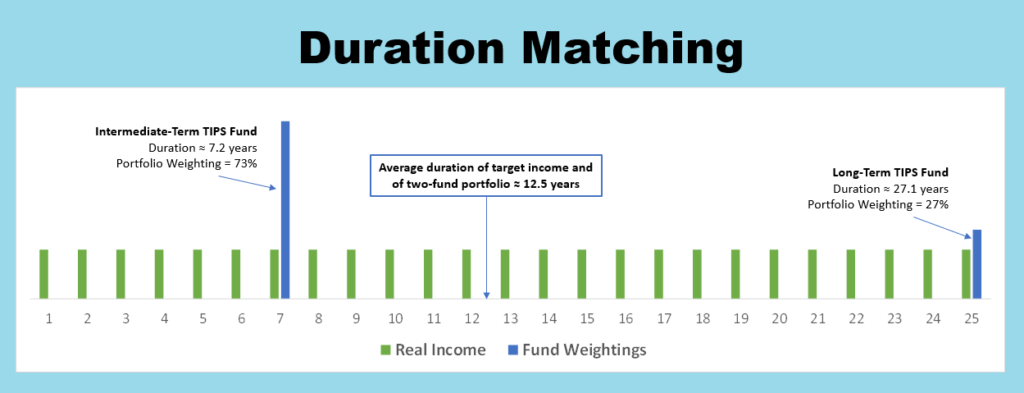At Round Table, we are big believers in what we like to call “true goals-based investing.” The idea is to match a client’s investment assets to their financial goals to the extent possible. We discuss this further on our Investment Management page, and of course we’d be happy to have a personalized discussion with you. (Importantly, nothing in any of our articles is ever personalized advice. One-on-one discussions are the only way for Round Table to craft personalized recommendations.)
For many investors, one of the biggest goals—really a combination of many goals—is retirement. To target the complexity of retirement planning, we developed the “Retirement Investment Layer Cake” model. In brief, we may divide a client’s retirement goals into categories like annual required/inflexible spending, flexible spending, large one-time purchases, emergency expenses, long-term care, legacy, etc. Then we divide the client’s assets into “layers” designed to target each of these goals.
For example, if Social Security isn’t sufficient to cover someone’s “inflexible” spending needs, we may recommend an “Inflation-Protected Income (IPI) Model” portfolio using government-guaranteed TIPS to build 20-30 years of additional inflation-adjusted income.[1]
A Brief Personal History
Back in 2009, in the spring semester at Harvard Business School, I had the privilege and pleasure of taking a course from Nobel Prize-winning finance professor Robert C. Merton. In virtually every class session, Prof. Merton introduced paradigm-altering insights into the world of finance, helping his students understand how innovative techniques in finance and investing could be employed—or misused, if employed improperly—toward solving problems faced by governments, businesses, and individuals.

[Source: Wikipedia, https://en.wikipedia.org/wiki/Robert_C._Merton,
Copyright: Massachusetts Institute of Technology, CC BY-SA 4.0 license]
Prof. Merton would joke that he enjoyed teaching when the world was falling apart (as it was back then, with the Great Financial Crisis unfolding before our eyes), because his students would believe him when he said that “risk/return” did not mean “wink-wink/return,” and that the tradeoffs in taking investment risk required a reasoned approach to the pros and cons.
As a practical example of how to reduce someone’s risk, he demonstrated a technology he had co-developed that could glide (a portion of) an investor’s portfolio toward the attainment of safe, secure, inflation-protected income in retirement. I was captivated by the concept at the time, and I have been ever since.
Prof. Merton’s original technology has changed over the years, and it now lives on at Dimensional Fund Advisors as the Dimensional Target Date Retirement Income Funds. (Incidentally, the technology also served as my introduction to Dimensional, where I wound up working prior to joining Round Table.) However, whereas Dimensional’s TDIFs are designed as a one-size-fits-all approach for people retiring in the general vicinity of a five-year window (2025, 2030, 2035, etc.), Round Table’s version of the concept is individually tailored to each of our clients, crafted to a customized set of inflation-protected income goals, as part of our personalized financial planning process.[2]
Quick Notes on TIPS
Prof. Merton’s, Dimensional’s, and Round Table’s solutions all use Treasury Inflation-Protected Securities (TIPS) to create inflation-protected income in retirement. We’ll post detailed descriptions of TIPS in other articles [UPDATE: Here you go!], but for now a quick introduction will be helpful to the following discussion.
TIPS are bonds issued by the U.S. Treasury and backed by the full faith and credit of the U.S. government. But whereas most Treasury bonds have a fixed “face value”—i.e., a pre-determined quantity of U.S. dollars that will be returned to investors on the bonds’ maturity date—the face value of TIPS bonds grows with inflation.
For example, the government might issue a new TIPS instrument maturing in five years’ time, with an initial face value of $100.[3] But then every day for the next five years, the face value will be adjusted upwards (by a tiny daily amount) to match the prevailing inflation rate.[4] Consequently, in five years, the bond will mature, and investors will receive $100 plus five years’ worth of CPI adjustments.
Like most bonds, TIPS also pay a (small[5]) “coupon” payment, twice per year. The coupon is paid out as a percentage of then-current face value, meaning the coupon payments adjust upwards with inflation as well.
Building an Inflation-Protected Income Stream with TIPS
Okay, so “Inflation-Protected” is literally TIPS’s middle name, but what about the “income” part? Two techniques we can employ are discussed below.
First, though, here’s what we’re not talking about: TIPS instruments are bonds, and when most people see “bonds” and “income” in the same sentence, they assume we’re talking about the coupon payments.[6]
Rather, it is the fact that TIPS promise to mature at today’s face value plus inflation that creates (most of[7]) the income opportunity. Each TIPS bond’s face value promises a guaranteed amount of inflation-adjusted buying power at the bond’s maturity date. And there are multiple TIPS maturity dates to choose from, ranging from near-term (for TIPS instruments that were issued in the past and are maturing soon) out to 30 years (the longest maturity currently issued by the Treasury).
Technique #1: Laddering
If an investor makes an up-front purchase of a sequence of TIPS, the maturities can be lined up to build an inflation-adjusted stream of income over a preselected range of years. For example, to create 25 years’ worth of income, the investor might (in theory; see below) purchase a TIPS instrument maturing in January of each year starting next year and continuing out to 25 years from now.
This technique is called “laddering,” since each bond’s maturity date can be viewed as a “rung” on a ladder of inflation-protected income that can be “climbed” for 25 years. The simplest way to think about this is that if we want to create income of, say, $10,000 of today’s buying power for each of the next 25 years, we could purchase $10,000 of current face value in each of 25 annual maturities of TIPS. The price to make these purchases will vary with market conditions, though as we noted in a prior article, that price has actually declined of late, despite the significant jump in prevailing inflation rates.

I’ll mention here that this “simplest” way to build a TIPS ladder suffers from a few complications. First, as stated above, TIPS make coupon payments twice per year. This complicates the math, since the bonds will pay out more, over time, than just the $10,000-plus-inflation maturity amount.[8] Additionally, a few rungs are missing: i.e., while there are convenient January or February maturities for most of the next 30 years, there are currently several years in the 2030s with no available TIPS maturities at all.
Technique #2 below is a partial solution to laddering complications. Beyond that, because we don’t want this article to graduate from intermediate-level to advanced-level reading—and hey, we do this for a living, so why give away all our secrets?![9]—we will simply state for the record that complications like these do prevent perfect precision in inflation tracking,[10] but for practical purposes workable solutions exist.
Technique #2: Duration Matching
Our second technique for building inflation-protected income with TIPS is easier to implement but harder to explain. Per the lame excuse above, we won’t attempt to explain “duration matching” in full, but here is the gist:
Again, suppose we are looking to create $10,000 of income once per year for the next 25 years. Thus $10,000 should arrive in 1 year, 2 years, 3 years, etc. out to 25 years. In a simplistic sense, then, the stream of income arrives “on average” in 13 years, 13 being the average of all numbers from 1 to 25. Naively, then, we might expect a single bond paying $25,000 in 13 years to have about the same price as a sequence of bonds paying $1,000/year for the next 25 years.
However, there are several additional considerations:
- Bonds accrue interest over time, so assuming interest rates are positive,[11] a longer-term bond will cost less today than will a shorter-term bond.
- Interest rates vary by maturity. I.e., a 25-year bond will likely have a different annualized rate of interest from a 10-year bond or a 1-year bond.
- We don’t actually want $10,000 per year, but rather $10,000 plus inflation (i.e., 10,000 “real” dollars) per year, such that the target income in “nominal” dollars[12] (i.e., the actual count of dollars we receive) grows larger year-by-year with inflation.[13]
The solution to the first two problems is to use a rather complex formula that calculates the weighted average timing of cash flows, adjusted for prevailing interest rates. The resulting number is known as the “duration” of the desired income stream.
The solution to the third problem is relatively simple: Instead of using nominal interest rates (e.g., from nominal/“normal” Treasurys), we can use “real” (i.e., before inflation adjustments) interest rates, as determined from TIPS. Applying the duration formula to real interest rates gives us a “real duration” figure.
The further real rates are from zero and the more they vary across the curve of bond maturities, the further duration can be from the “average” payment date (13 years in our example). Right now, for example and depending on certain assumptions, the duration of that 25-year income stream might be about 12.5.
As it turns out, two portfolios with the same duration will have a very similar sensitivity to changes in interest rates. This means a TIPS portfolio with the same duration as that of our 25-year income target will move up and down in value in a manner that mirrors that of the present value of the income stream itself. It will also have a similar up-front price as a bond ladder. Consequently, a duration-matched portfolio of TIPS can be used to produce a decent facsimile to the present value of an inflation-adjusted income stream. Duration matching produces somewhat less precise inflation-protected income matching, but it can give us somewhat greater flexibility to make adjustments as necessary.[14]
In practice, we can combine two mutual funds to produce a portfolio designed for inflation-protected income:
- A long-term TIPS fund (i.e., with a high duration) and an intermediate-term TIPS fund can be combined to match the duration of a long-term stream of inflation-protected income (see the example below).
- The intermediate-term fund and a short-term fund can be combined to match the duration of a short-term stream of inflation-protected income.

Use Cases for Each Inflation-Protected Income Technique
In practice, for clients for whom the IPI model is relevant, we may use the duration matching technique in someone’s pre-retirement years, when the IPI Model is on a glidepath toward inflation-protected income. Where practical, we may then switch to a TIPS ladder when the (near-)retiree is ready to select a defined income stream. But even then, the duration matching technique may be employed to fill in for any years where there are no TIPS maturities.
Importantly, both techniques involve setting up a portfolio to be fully consumed as income over a pre-determined number of years. In other words, this model seeks inflation-protected income, and in exchange it sacrifices any focus on asset growth in retirement. We will post a follow-up article at some point with more details on the benefits and tradeoffs of the IPI model, but for growth-oriented goals, Round Table can recommend other strategies.
Inflation-Protected Income Model in Context: The Second Layer of the Layer Cake
In Round Table’s Layer Cake retirement investment system, the IPI Model is just one piece of a multifaceted methodology for targeting various retirement goals with various goal-oriented portfolios/assets. We believe there is no one-size-fits-all strategy: not across clients, nor even across the different goals that each client will have.
We most commonly view the IPI Model as a supplemental source of inflation-protected income when Social Security is insufficient to cover relatively inflexible annual spending needs and/or as a means of creating an “income bridge” from someone’s retirement date to when they claim Social Security benefits. But again, a personalized plan is required to determine whether and how the IPI Model might make sense for an investor. If you would like to have a personalized discussion about how an investment plan can be tailored to your specific goals, please feel free to reach out to us.
[1] Of course, a retiree might live more than 20-30 years. To hedge longevity risk, we may additionally recommend the purchase of a deferred income annuity (DIA, sometimes called a longevity annuity or longevity insurance) that picks up when IPI income concludes. Unfortunately, as of this writing, CPI-adjusted DIAs are unavailable in the marketplace, so while you can purchase separate products to hedge inflation risk (TIPS, via the IPI Model) and longevity risk (DIA), there isn’t currently a product on the market that supplements Social Security’s coverage of both risks.
[2] Notably, Dimensional itself has done a great deal of research around more personalized solutions. For example, see the academic article, “Investing for Retirement Income: A Comparison of Asset Allocations for Spending Strategies,” by Dimensional’s Mathieu Pellerin.
[3] Notably, you almost certainly will not pay exactly $100 to acquire this instrument. The price is set by the market, and can be more or less than $100, depending on prevailing interest rates, prevailing inflation expectations, etc.
[4] Technically this occurs with about a two-month lag. For example, the inflation rate for the month of June was announced on July 13, and TIPS face value began accruing the June rate of inflation on August 1.
[5] For most outstanding TIPS instruments, the annualized coupon rate is a fraction of a percent, but a few off-the-run TIPS were issued with coupon payments in the 2-3% range. As we explain in the next section, a higher coupon payment isn’t necessarily helpful to the goal of crafting inflation-protected income.
[6] If this sentence meant nothing to you, congratulations! You have nothing to unlearn.
[7] Refer back to the coupon being an annoyance.
[8] Granted, this sounds like a rather pleasant complication. But remember, the market knows about the coupon payments too, and it will charge you more up-front because of them. TIPS are a fantastic tool, but they are not a free lunch.
[9] FULL DISCLOSURE: Since this process is in fact (part of) what we do for a living, we charge a modest asset-based fee for our services. On the one hand, our fee adds additional complexity to the calculation. On the other hand, to the extent the fee and the coupon cancel out, the fee doesn’t change the complexity of the overall process by very much.
[10] For that matter, the two-month CPI lag prevents perfect precision as well.
[11] Not always a safe assumption with TIPS! For example, as of this writing, TIPS rates are positive for maturities greater than one year but negative for shorter maturities. But not long ago, TIPS rates were negative all the way out to 30 years, as we discussed in our prior article.
[12] I know, I know, I still owe our readers an explanation of “real” vs. “nominal” dollars.
[13] This assumes, of course, that inflation itself is positive, which is also not always a safe assumption. But of course, to the extent that we are looking to hedge against changes in cost of living, a potentially declining cost of living is not really the concern.
[14] We’re talking here about adjustments like, “Hey maybe I really want my income to start in year 2 and go to year 26 instead.” That’s a minor shift with a duration-matched portfolio, and potentially more of a pain with a ladder. However, a different set of adjustments is unnecessary with a ladder but required with duration matching: Over time, (A) interest rates change, (B) the amount of time to the next year of income changes, and (C) income gets taken out of the portfolio once per year. All these things cause duration to change. Consequently, a duration matching portfolio needs to be dynamic, with adjustments to portfolio weightings matching the evolution of duration.
Money plant photo created by jcomp – www.freepik.com
DISCLOSURES: All content is provided solely for informational purposes and should not be considered an offer, or a solicitation of an offer, to buy or sell any particular security, product, or service. Round Table Investment Strategies (Round Table) does not offer specific investment recommendations in this presentation. Reading this article does not create a client relationship with Round Table. This article should not be considered a comprehensive review or analysis of the topics discussed. Investing involves risks, including possible loss of principal. Despite efforts to be accurate and current, this article may contain out-of-date information, Round Table will not be under an obligation to advise of any subsequent changes related to the topics discussed in this article. Round Table is not an attorney or accountant and does not provide legal, tax or accounting advice. This article is impersonal and does not take into account individual circumstances. Reading this article does not create a client relationship with Round Table. An individual should not make personal financial or investment decisions based solely upon this article. This article is not a substitute for or the same as a consultation with an investment adviser in a one-on-one context whereby all the facts of the individual’s situation can be considered in their entirety and the investment adviser can provide individualized investment advice or a customized financial plan.
The data shown in this article is for informational purposes only and should not be considered as an investment recommendation or strategy, or as an offer to buy or sell any particular security, product, or service. Past performance may not be indicative of future results. While the sources of data included in any charts/graphs/calculations are believed to be reliable, Round Table cannot guarantee their accuracy.
